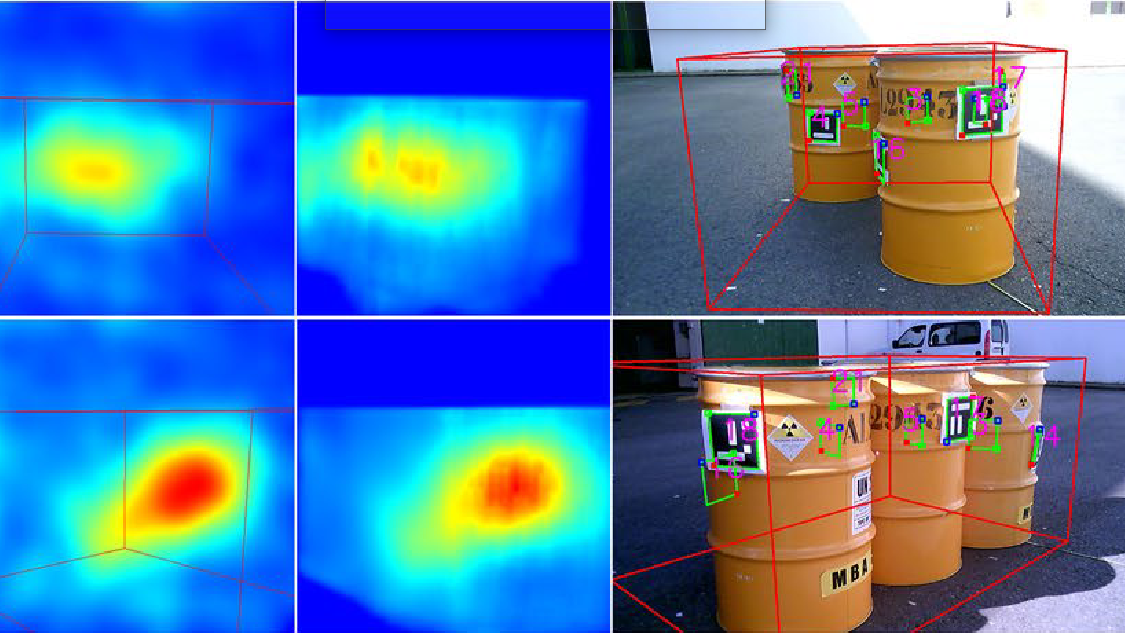The Institute of Corpuscular Physics (CSIC-UV) and the National Radioactive Waste Company are developing a portable system to visualize radioactivity with augmented reality and artificial vision. The results of this system are published in 'Scientific Reports', and derive from a patent licensed to a company of the Westinhouse group, present worldwide in the nuclear market
The Institute of Corpuscular Physics (IFIC, CSIC-UV), a joint center located in the scientific and academic area of the University of Valencia Science Park (PCUV), together with the National Radioactive Waste Company (ENRESA), has developed a system for visualizing the activity of the waste stored in nuclear safety containers and drums. It is a technique which combines gamma ray tomography and artificial vision. Its portability and its independence from the geometry of the radioactive waste make it possible to carry out complex tomographic reconstructions, thus optimizing the nuclear waste classification processes.
One of the main activities of the nuclear industry is the characterization of radioactive waste based on the detection of gamma radiation, a type of electromagnetic radiation consisting of photons and generally produced by radioactive elements. Large volumes of waste are classified according to their average activity inside the containers, but often the radioactivity exceeds the maximum allowed by regulatory agencies in specific parts of the container.
Currently, radiation detection is performed by clinical tomography techniques, based on static systems in which the geometry of the object to be observed and also that of the detector are fixed and well known. These systems are not portable and depend on the transfer of patients to the locations where the detection systems are located. However, in the case of stored radioactive waste, where the geometry varies and its transport is complex, the situation becomes more complicated.
"Its advantage for clinical applications lies in its high detection efficiency and image resolution, which allows obtaining information in a shorter time compared to conventional systems", César Domingo Pardo, IFIC researcher
New waste management model
IFIC and ENRESA have developed a new nuclear waste management model which solves these problems. It is a portable and geometry-independent tomographic system which allows the three-dimensional reconstruction of images for detecting gamma radiation.
This system uses a gamma radiation camera and a visible camera that, combined, allow the visualization of radioactivity using augmented reality and computer vision techniques. A disruptive innovation in the nuclear industry that will make it possible to accurately detail the real activity of radioactive waste, optimizing the classification process for its subsequent treatment, its correct storage and its final control.
"This technique makes it possible to develop transportable devices that can be easily maneuvered by workers in the sector and that guarantee precise measurements of the activity of the waste, making the invisible visible," says Salvador Tortajada, co-author of the work. "This means safer management of radioactive waste and reduces uncertainties regarding control and management by future generations," adds Francisco Albiol, CSIC researcher at IFIC and co-author of the research.
"This technique makes it possible to develop transportable devices that can be easily maneuvered by workers in the sector and that guarantee precise measurements of waste activity by making the invisible visible", Salvador Tortajada, co-author of the paper
This work, product of a patent owned by the University of Valencia, CSIC and Enresa, has been recently published in Scientific Reports, a journal of the Nature group. The patent was licensed to Tecnatom, a company belonging to the Westinhouse multinational group, present worldwide in the nuclear market. It is a non-exclusive patent for the Spanish territory.
The collaboration between Enresa and IFIC for the development of the new technology has already generated two doctoral theses, one on environment recognition applied to resources and the other, of an industrial nature, on volumetric evaluation systems. These, in turn, have generated two new industrial patents.
Reference:
Tortajada, S., Albiol, F., Caballero, L. et al. A portable geometry-independent tomographic system for gamma-ray, a next generation of nuclear waste characterization. Sci Rep 13, 12284 (2023). https://doi.org/10.1038/s41598-023-39405-x


